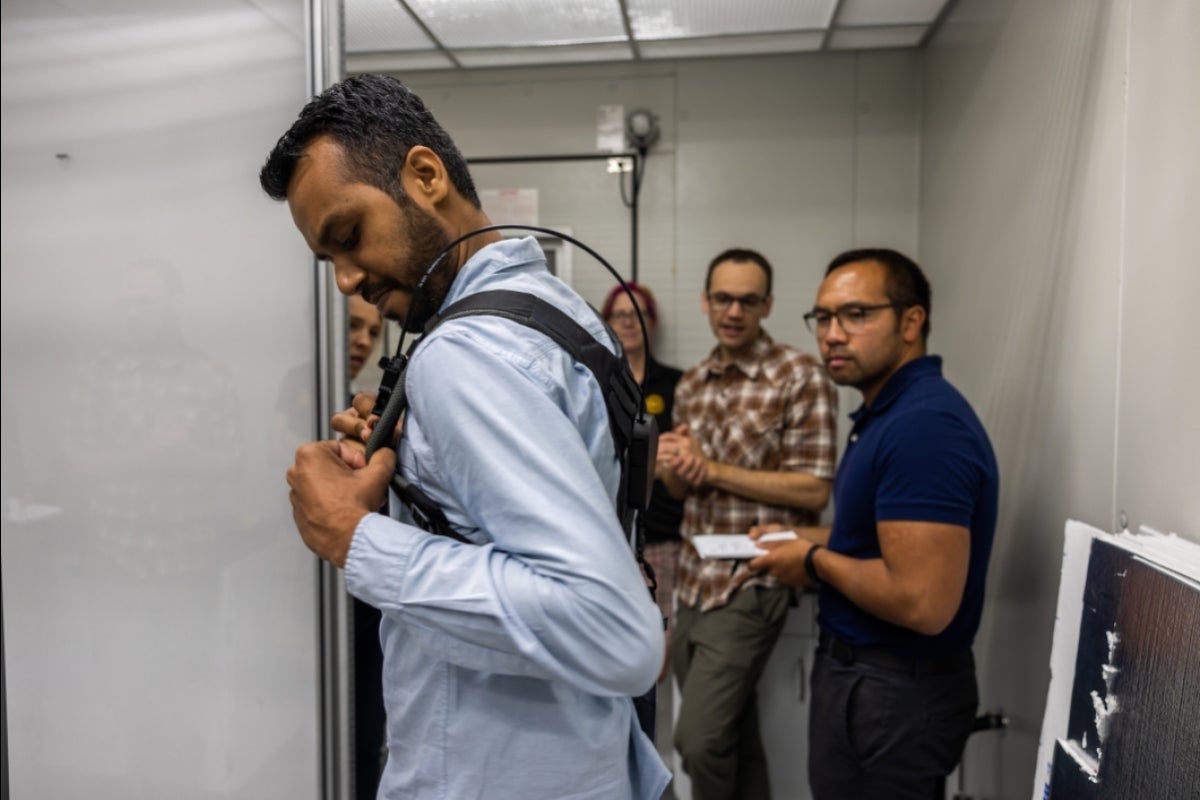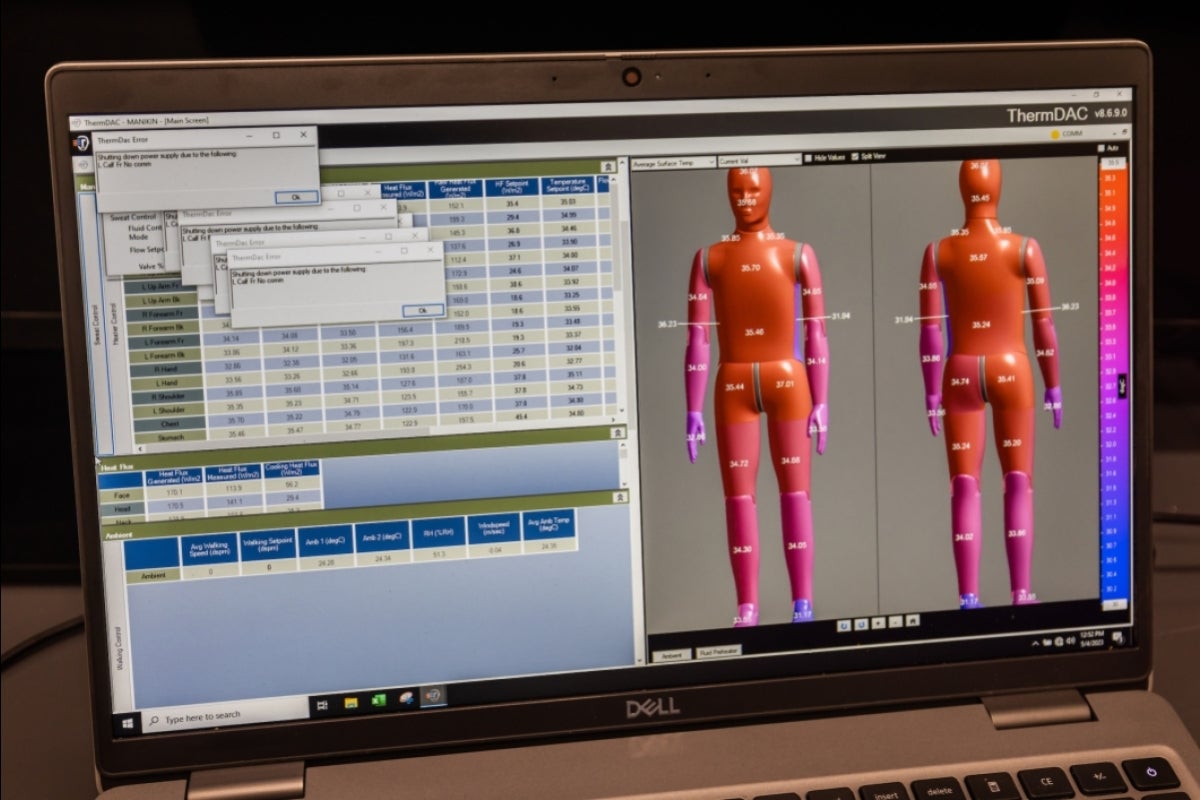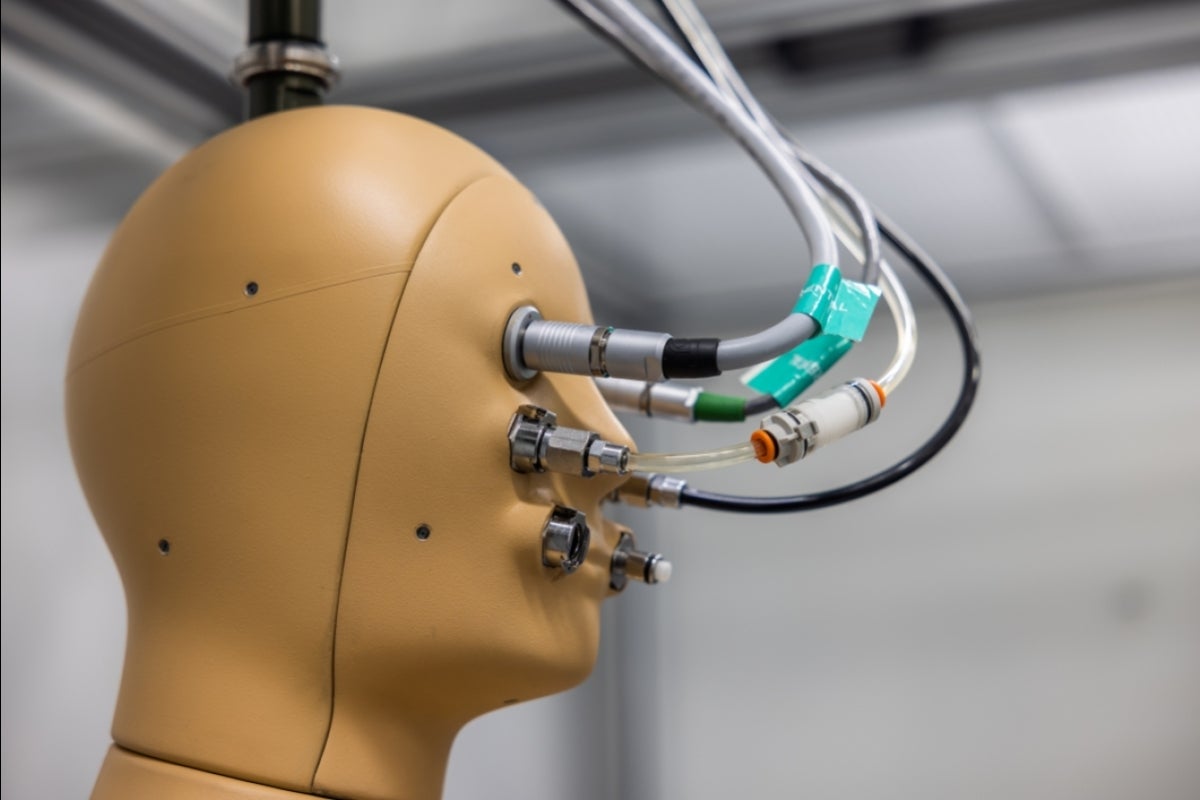Behind a 4-inch-thick metal door with a small glass window in the far northeast corner of Arizona State University’s Tempe Campus lives ANDI, the world’s first indoor-outdoor breathing, sweating and walking thermal manikin.
ANDI is funded by an NSF Major Research Instrumentation Grant and is custom-built for ASU by the company Thermetrics. He can mimic the thermal functions of the human body and has 35 different surface areas that are all individually controlled with temperature sensors, heat flux sensors and pores that bead sweat.
“ANDI sweats; he generates heat, shivers, walks and breathes,” said Konrad Rykaczewski, associate professor in the School for Engineering of Matter, Transport and Energy and principal investigator for a new ASU research project aimed to measure the effects of extreme heat on human health.
“There's a lot of great work out there for extreme heat, but there's also a lot missing. We're trying to develop a very good understanding (of how heat impacts the human body) so we can quantitatively design things to address it.”
Around the globe, 10 ANDI manikins currently exist, mostly owned and used by athletic clothing companies for garment testing, but ASU’s ANDI is only one of two used by research institutions and it's the first thermal manikin in existence that can be used outdoors, enabled by a unique internal cooling channel.
In the coming decades, every region in the U.S. is expected to experience higher temperatures and more intense heat waves. Thousands of people around the country die from heat-related illnesses each year, and in Maricopa County alone in 2022 there were 425 heat-related fatalities, a 25% increase from the previous year.
ASU researchers aim to better understand heat stress on the human body and what makes hot weather so deadly.
Using both ANDI and a heat chamber in which ANDI lives, Rykaczewski, Jenni Vanos, associate professor in the School of Sustainability, and Ariane Middel, assistant professor in the School of Arts, Media and Engineering, are working togetherCo-principal investigators include: Middel and Vanos, as well as David Sailor and Stavros Kavouras. Additional senior personnel include Dongwoo Jason Yeom, Floris Wardenaar, Pat Phelan, Sangram Redkar, Dennita Sewell and Jason Siegler. Also involved are Galina Mihaleva and Daniel Collins. to better understand how our human bodies are impacted by heat stress and quantify the risk different environments pose to health.
“You can’t put humans in dangerous extreme heat situations and test what would happen,” said Vanos, whose research connects extreme heat to human health, specifically for active populations, like children, outdoor workers and athletes. “But there are situations we know of in the Valley where people are dying of heat and we still don't fully understand what happened. ANDI can help us figure that out.”
Built for the outdoors
Inside ANDI’s current home, ASU’s newly developed heat chamber, researchers can simulate heat-exposure scenarios from different places around the globe.
Dubbed the “Warm Room,” the heat chamber is outfitted with advanced technologies that control the wind, temperature up to 140 degrees Fahrenheit and solar radiation.
But in addition to being studied indoors, ASU’s ANDI is the only thermal manikin in the world that is able to be used outside.
ANDI is built with internal cooling channels that circulate cool water throughout its body, which enable him to stay cool enough to withstand extreme heat while measuring complex variables that contribute to our perception of heat in different environments — solar radiation from the sun, infrared radiation from the ground and convection from the surrounding air.
This summer, researchers will pair ANDI with MaRTy, ASU’s biometeorological heat robot, to work together and better understand human sweating mechanisms, like changing skin temperature and changing core temperature, and identify how specific environments may enhance heat risk.
“MaRTy can tell us how the built environment modifies the amount of heat that hits the body, but MaRTy doesn't know what happens inside the body,” said Middel, who studies urban climate and how urban environments influence weather hazards. “MaRTy measures the environment, and then ANDI can then tell us how the body can react.”
The ANDI and MaRTy duo will first be walking around ASU’s Tempe campus together and eventually make trips around the greater Phoenix area to be tested in heat-vulnerable environments, like exposed streets and old mobile homes where the AC went off.
People experience heat differently
Outside in 115-degree Fahrenheit temperature, an elderly man with diabetes will experience heat stress differently from an active woman in her mid-30s, and differently from a child in elementary school. Age, body size and other characteristics of overall health play critical roles in how people respond to extreme heat.
ASU researchers can account for variations in body type and health characteristics to create and input into ANDI different customized thermal regulation models for almost anyone in the U.S.
“We can move different BMI models, different age characteristics and different medical conditions (into ANDI),” said Ankit Joshi, an ASU research scientist leading the modeling work and the lead operator of ANDI. “A diabetes patient has different thermal regulation from a healthy person. So we can account for all this modification with our customized models.”
Solution forward
With the data and information collected, researchers hope to design interventions, such as cooling clothes or exoskeletons for backpacks that are designed for cooling support.
“We're trying to approach this from a very holistic point, but there's not going to be a silver bullet for anything,” Rykaczewski said. “This project very much involves students from engineering, sustainability, in addition to people with backgrounds in weather and even fashion.”
The team is actively recruitingIf interested, email Konrad Rykaczewski at konradr@asu.edu. undergraduate, graduate and postdoctoral students to participate in this project. And as the team says, ANDI could always use more friends.
This project is funded by the National Science Foundation's Leading Engineering for America’s Prosperity, Health and Infrastructure (LEAP HI) program.
Top photo: (From left) Associate Professor Konrad Rykaczewski, research scientist Ankit Joshi, ANDI the thermal manikin, Associate Professor Jenni Vanos and Assistant Professor Ariane Middel in the lab. Photo by Christopher Goulet/ASU
More Health and medicine

Reducing waste in medical settings
Health care saves lives, but at what cost? Current health care practices might be creating a large carbon footprint, according to ASU Online student Dr. Michele Domico, who says a healthier…

ASU offers bilingual counseling to Spanish speakers
Arizona is one of the five states in the nation with the highest percentage of Hispanic residents, according to the U.S. Department of Health and Human Services Office of Minority Health, and …

College of Health Solutions launches first-of-its-kind diagnostics industry partnership to train the workforce of tomorrow
From 2007 to 2022, cytotechnology certification examinees diminished from 246 to 109 per year. With only 19 programs in the United States, the cytology workforce that stands at the front line of…







